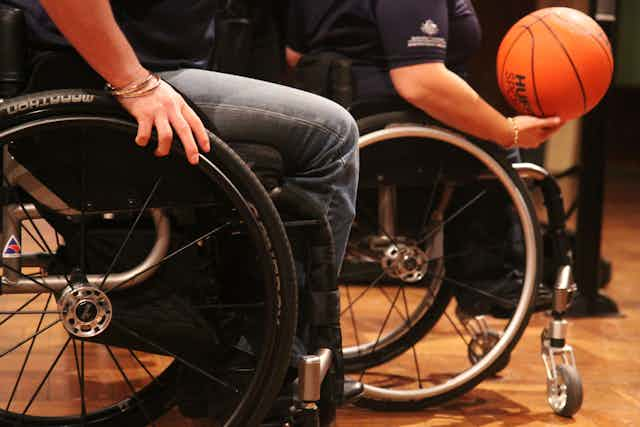Equipment such as wheelchairs or prosthesis is fundamental in allowing some people with disabilities to carry out the tasks of daily living. But in the endeavour to go higher, faster and longer, athletes with a disability have found these standard devices can inhibit their sporting performance. So where do these two worlds meet?
Paralympic sports evolved from medical rehabilitation programs in the 1950s. The objective of a rehabilitation program is to regain a level of function for the client.
For an athlete with a disability, the highest expression of this return to function is to compete at an elite level in the Paralympic Games.
To satisfy the demands of elite athletes, significant new technological developments in wheelchair design and prostheses have occurred, demonstrated by radical equipment designs such as seated throwing chairs, racing wheelchairs, and running prosthesis.
As technological advances continue to provide opportunities for improved athletic performance, an ongoing challenge for international sporting bodies is to determine if the use of a given technology represents “performance enhancement” or, rather, is “essential for performance”.
A base to work from
The traditional wheelchair (or day-chair) design consists of two larger wheels at the rear of the chair to allow forward propulsion via the push-rims, and two small smaller wheels at the front of the chair to provide stability.
The steering of the day-chair is controlled by manipulating the rear wheels, either braking or propelling more on one side to change direction.
But the unique requirements of sporting use have modified this conventional design dramatically. Due to the need for rapid acceleration and to change direction suddenly in wheelchair basketball (see top video) and wheelchair tennis (see video above), many chairs now incorporate a fifth wheel at the back, preventing the chair from flipping backwards during play.
Different strokes
In the high-impact sport of wheelchair rugby (see video below), the chairs are also fitted with reinforced front and side bumper guards that have special “hooks” to trap opposition players. Players in such sports must often move quickly and change direction rapidly while carrying or holding balls or rackets.
To accommodate this, the camber (angle) of the rear wheels is increased to facilitate a quicker “grab” of the rear wheel. This increased camber also improves hand protection when two chairs collide on the court and improves turn velocity.
For athletes who compete on the track or road, racing wheelchairs resemble a cross between a wheelchair and a bicycle. As with sport-specific prosthetic limbs, there are sport-specific racing wheelchairs that are lighter, will track in a straight line and are aerodynamically designed to enhance track performance.
For straight line racing on the track or road (see video below), the racing chair has evolved with an extra long-wheel base and a single large front wheel.
The push-rims are considerably smaller on the racing chair as the biomechanics of this configuration requires less arm movement but greater push. As a wheelchair racer will generally only compete against fellow wheelchair racers, the issue of performance enhancement is a moot point as the technology is essential for performance.
But the equity of access to this wheelchair technology must be addressed.
Advances and application
Advances in technology underpin such assistive devices. The development of the energy-storing prosthetic foot can make a lower-limb amputee’s gait more efficient and ambulation faster.
When this revolutionary prosthetic technology was specifically applied to sprinters, studies showed that running velocity was significantly increased.
But the application of this technology has been controversial, as clearly demonstrated by the much-publicised Oscar Pistorius or “Blade Runner” debates before the 2008 Beijing and the 2012 London Olympic and now Paralympic Games.
The skill of the athlete, coupled with this new prosthetic technology, enabled Oscar to enter qualification in the men’s 400m sprint in both the Olympic and Paralympic Games.
Although not discussed in peer-reviewed literature, it is well documented in the press and sports communities that both the Olympic and Paralympic movements struggle with the role of technology in the sporting arena.
In the best interest of the athlete, and to avoid potential legal problems and unwarranted issues, the role of technology needs to be clarified.
In particular the speculation that advances in technology create a greater advantage than the best performance-enhancing drugs – giving rise to the often-heard comment: “Who’s going to win the gold medal, the athlete or the technician?”
Match fit
A fundamental aspect of the above problem is for the sport scientist to effectively “match” the technology with the athletes’ requirements.
Simply picking up an elite athlete’s equipment will not result in a world championship performance. If an athlete uses Roger Federer’s tennis racket, that alone will not produce a Grand Slam-level performance.
The right matching requires skill, commitment, opportunity and technology. As such, advances in wheelchair technology are essential for an athlete to perform.
And ultimately this new knowledge will translate into more functional wheelchair devices for daily activities in the broader population.

